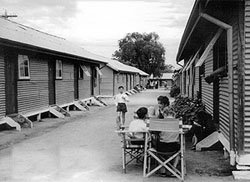
A friend and colleague, Noric Dilanchian, sent me photos of two stamps and challenged me to write a story about each. I covered the first stamp in a story I wrote on the New England, Australia blog about the history of the CWA. This is the story of the second stamp.
The stamp on the left celebrates the Colombo Plan. For most Australians, the Colombo Plan has now vanished into the mists of the past. That's a pity, for the Plan marked a crucial turning point in Australia's engagement with Asia and in the transformation that has taken place in this country over the last sixty years.
Thinking about this and how best to handle Noric's challenge, I decided to take my last post on this blog as a starting point. In that post I reported on a tour of the blogosphere that I had done looking at blogs in some ways generated by the war on terror, how depressed it made me feel, but how it had also made me realise that Australia really was different from most other countries.
I also felt, although I did not say this, that we needed to recognise this if we were to avoid adopting externally created stereotypical black and white positions that were in fact alien and antipathetical to our own culture and experience.
Last year Don Aitkin published a rather good book called What was it all for?. Its starting point was the 50th year reunion of the Armidale High School Class Leaving Certificate class of 1953. Having attended the reunion, Don decided to write a book about the changes in Australia since the end of the Second World War War as seen through the eyes of the class of 53. He concluded that Australia had gone through a most remarkable and perhaps unique transformation and, what's more, had done so without tearing the social fabric apart.
I think that Don is right. I also suspect that the unique nature of the transformation is simply not recognised by either Australians or those elsewhere in the world and that it has real present lessons for us and the rest of the world.

These are big claims. So let me start by sketching out a few parameters :
- In 1945, the Australian population was just over 7 million. Ninety per cent of this was Australian born, another 8 per cent born in New Zealand or the UK. The Anglo-Celtic proportion of the population was probably over 95 per cent.
- Since 1945 we have admitted 5.9 million migrants. While many of those migrants came from the UK, the need for people meant that we brought in millions of people including those displaced by the war from many European countries as well as huge numbers from countries like Italy and Greece. Even today, Melbourne is the third largest Greek city in the world. Dozens of ships such as the SS New Australia (pictured) were devoted to shipping the huge number of migrants, many of whom were housed in temporary camps such as the Bonegilla Migrant Reception and Training Centre (pictured).
- The White Australia policy was central to the early post-war immigration policy. This policy had its roots deep in 19th century history, reflecting the fear that Asian migration would threaten the living standards of Australia's workers and swamp the European population. Thirty years later White Australia had gone, replaced by a consciously non-discriminatory migration policy.
- Migration has transformed the country. Today almost 25 per cent of Australian residents were born outside the country, around 50 per cent have at least one parent born outside the country. Our migrants have come from 185 countries. The anglo celtic proportion of the population has dropped from over 95 per cent to 74 per cent, with 19 per cent other European and 4.5 per cent Asian.
- We continue migration on a relatively large scale. Over the next ten years we are likely to admit another 1.5 million migrants, the majority coming from non-European countries. I am only guessing, but given the number of Muslim majority population countries that we are drawing migrants from, it seems likely that Muslim proportion of the Australian population will at least double.

These are dramatic changes by any measure. I think that Don is probably right when he suggests that no other country has experienced such dramatic changes in the composition of its population with so little ethnic or racial disturbance. The recent troubles at Cronulla achieved such prominence in part because they were so rare.
The Colombo Plan was part of the transformation process. In the next few posts I will look at the Plan as well as other elements in the transformation process through the prism set by my own experiences.








No comments:
Post a Comment